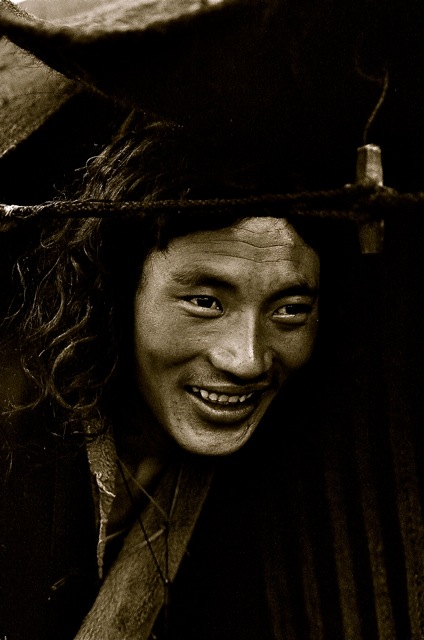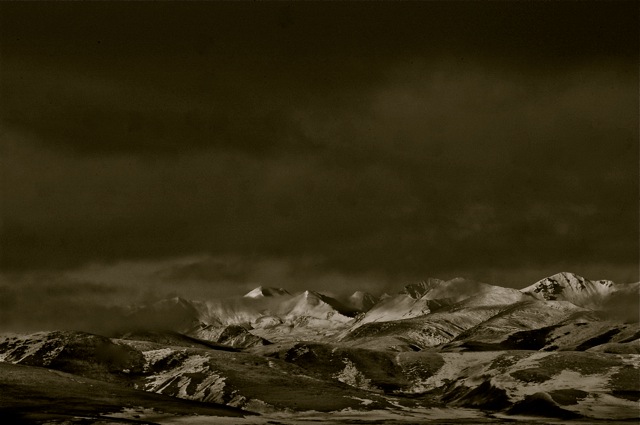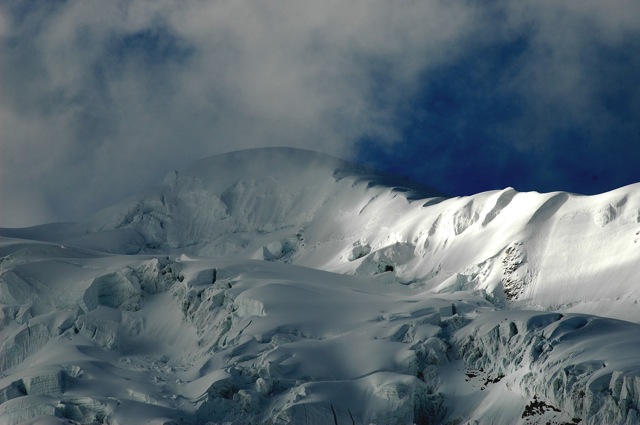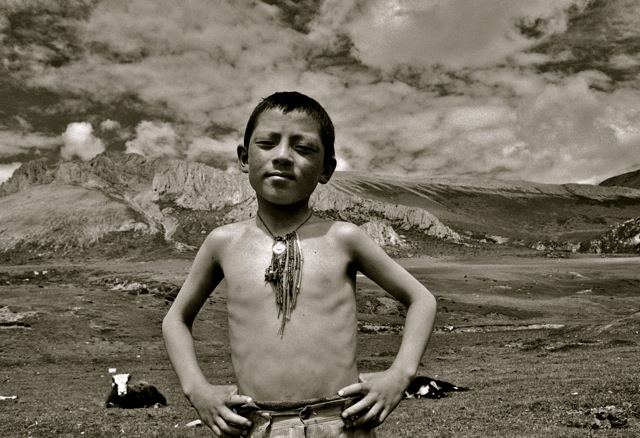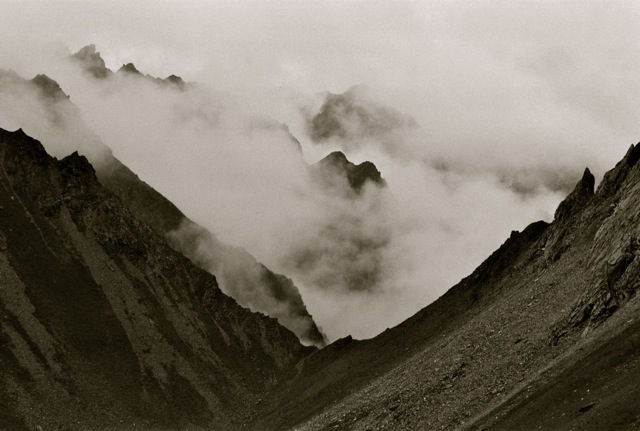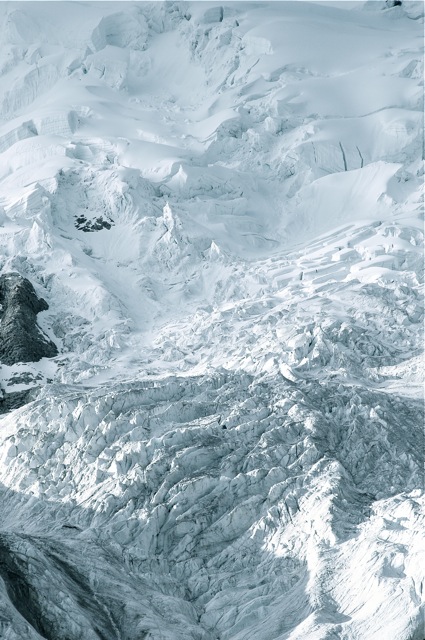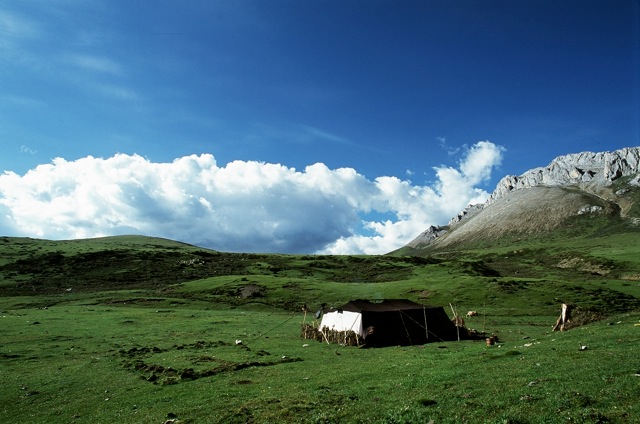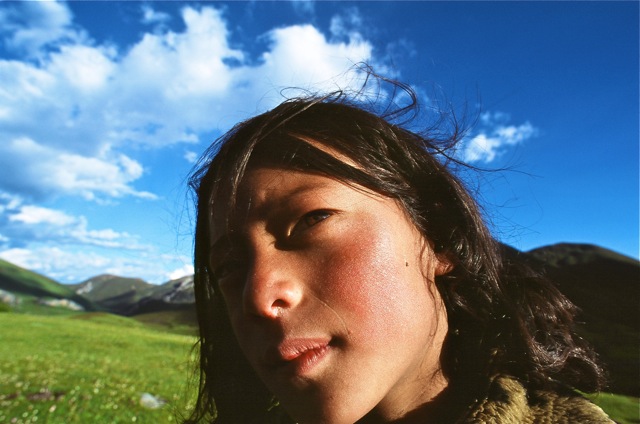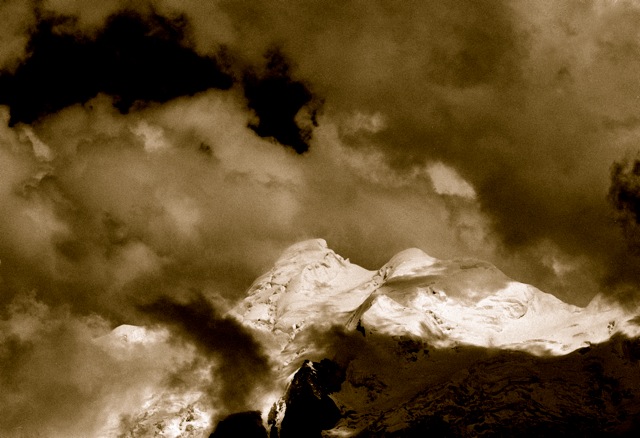Brongri is a mountain god that is only called upon when nomadic disputes have reached a level when they cannot be solved by the mortal will. It should be noted that the Tibetan nomadic mortal will, whether in pursuit of good or not, can be a very substantial force of nature. Brongri’s invitation to settle is only issued when things have reached an untenable level…when blood ‘letting’ is an inevitability.
This tale is one told around the fierce regions of ‘Ba-Litang’, in western Sichuan province; a region of intense people and even more intense lands. It is also the home of a mountain range, sacred to the nomads. Known as Genyen it is not a mountain that is accidentally come upon or found; it is a mountain that one needs to ‘go to’.
When Brongri is needed, an elder nomad will go to pray and listen…and listen some more before deciding on the right decision to make.
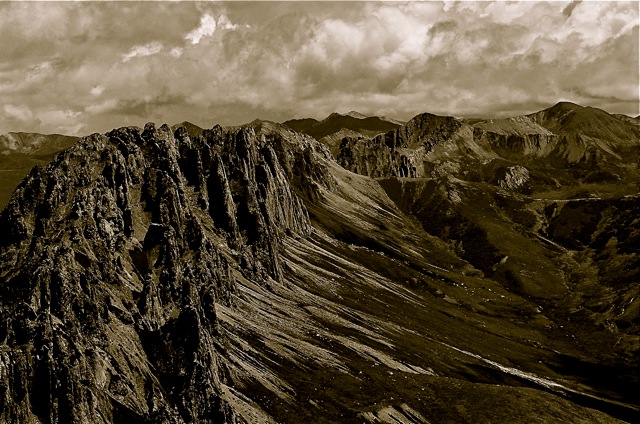
Mountain folds create barriers and also offer up 'routes' and pathways to weave through the mountains
Lying south of Litang along a road that challenges one’s imagination, the lands around Genyen are coated with brittle rock, perpetual winds and the solid black yak wool tents (ba). The nomads (drok’pa) are compelling in deeds and in esthetics. Paths that bravely wander around the black spires and mountains were once conduits and side-paths that led to the greater trade routes. Linking some of the most remote communities with the Tea Horse Road (Gya’lam to the Tibetans) the routes allowed a little luxury into the highlands. Roads do not enter into the abyss of beauty, they simply halt.
Lives worn down to a few essentials, the nomad’s features betray only blazing toughness and direct emotions. Here there is nothing fatuous or patronizing. There is clarity and unambiguous answers and questions. The mountain’s very character is revealed in the mortal bodies. There are few ambiguities at this altitude simply because there cannot be.
One reaches the town of Dranla, exits a vehicle and makes one’s way further south and then west to a town of Leykundo, which in good weather sits next to a small curling river, the Nay’chu; in times of precipitation the town lies along torrents of ice- cold water, hail and snow.
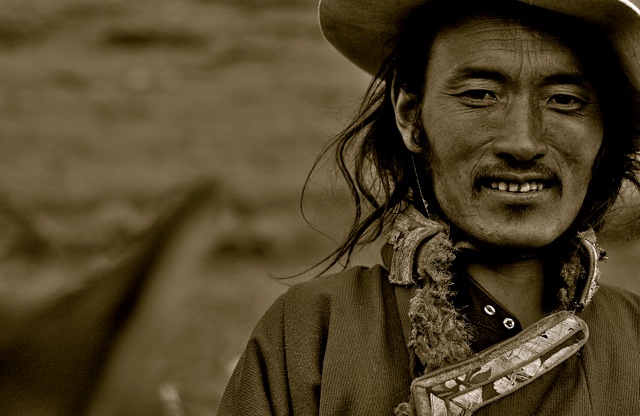
Nearby Yena town sits in a tucked away valley and the population is a couple dozen. Here, one of the more well traveled of its residents near Genyen Mountain.
The Neygo monastery that hangs along a valley’s slopes, reminds the imagination that such places can and do still exist. Spaces and portions of land that lie still with none of man’s tricky colours, noises nor ‘versions’. Forces here are entirely of the earth and its atmospheric moods with altitudes, even within the valleys of over four thousand metros.
My own journeys there – once during the Tea Horse Road expedition and another on a journey to document nomadic life – cemented the place as one of those gems of the globe that one needs to look twice at, or more. It is land of rampant power and relentless mountain folds. It holds that kind of ominous charm of a place that can swallow you up even on bright sunlit days.
From Neygo, one continues to circumambulate further heading west around the main peak which pierce the clouds at six thousand two hundred metres. A waterfall, Trang Bhabshag murmurs softly, in contrast to the powerful landscapes around it.
The brute shape of Cherezig Mountain spears the sky beyond to the north and the nearby remnants of the fabled King Gesar of Tibetan lore’s battles with demons lie scattered near Shap Jebo. Caves and monstrous stones – cast from the sky – lie in odd places breaking up the rolling high-mountain grasslands (thang/tang).
One impulsive journey up to a snow crest above five-thousand metres during a storm of snow imparts a sense of the place. Blue sky off to the east, a daunting black swell coming in from the west and above a pummeling of white glorious precipitation. Then in an instant everything but the wind stills and a sky bolts out of a hole above, lighting a knife edge snow-line.
A community of a dozen or so nomadic families – all somehow related through blood and effort – sit in a wide valley at almost five thousand metros. Shinzhugong it is called and it marks one of the ancient summer homes of a clan of nomads. Fuel is scarce and the ubiquitous yak patties are the equivalent of mud-coloured gold for the warmth they can produce in the winter fires. Children occupy a level of toughness that is both endearing and astonishing, blandishing bare chests in an environment that can see snow cascade down in August. All things and sensations are immediate and entirely tangible.
During a tea break in a tent that billowed about in an afternoon storm, the tent’s contents seem at once brilliant and vital. In these few essentials there is a kind of string that leads back to lives uncluttered by anything but their precious needs – which in many ways remain unchanged.
Butter tea served straight into wooden bowls. Outside of the blowing flap of the tent a thick crusted layer of white sits atop the great beast that is the Genyen peak. I am told that the mountain watches over the community, its yak and its fortunes. As long as the peak is visible, all is well. Winds whip down off the crystalline slopes, and up and over the ‘minor’ hurdles – five thousand metre bodies of stone.
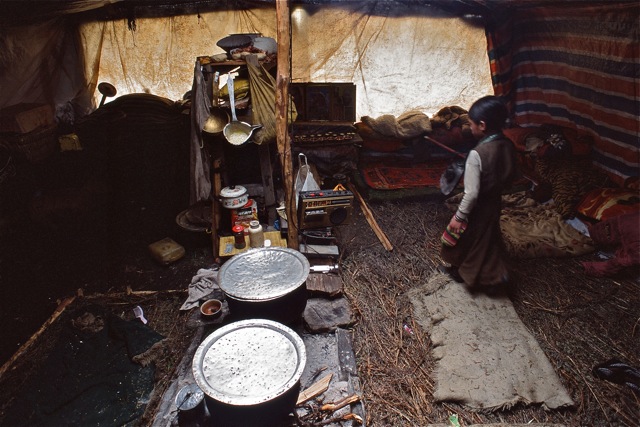
Only essentials within the nomadic tent. A fire and cooking space occupies the central portion of the home. By night the blankets and wools are piled thick and used for the cold dark.
When I ask about the mountain gods, I am instead told of blood feuds that occurred in the past; of how vengeance and retribution could decimate clans and relationships. Now Brongri is no longer needed. The mountain itself seems a totem of isolated force.
Two days later crossing an enormous grassland our little team of five come upon another summer nomadic residence. North of us another profile of the great mountain range offers itself to the eyes. A local nomad tells of Genyen being forgotten by even locals and how fewer pilgrims make their way to its base. He tells me that the peak is the creator of winds and how winds are essential for life (an often repeated Tibetan sentiment). The mountain has never been successfully climbed, though it has claimed life as early as a few years ago.
Later that night a moon blasts icy light against the ice crust of the peak – it reflects cold blue light like a beacon of the heights – reminding that to notice and revere it, even briefly, is enough.

